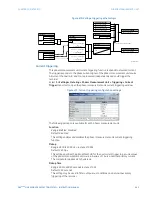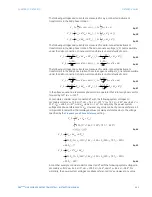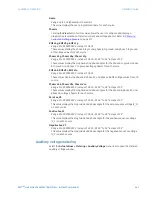
CHAPTER 11: METERING
PHASOR MEASUREMENT UNIT
D90
PLUS
LINE DISTANCE PROTECTION SYSTEM – INSTRUCTION MANUAL
555
Device Time
Range: time in HH:MM:SS format
Default: 00:00:00
This value reflects the time programmed in the D90
Plus
. This time cannot be modified
from this window.
PMU One-Shot Date
Range: date in MM/DD/YYYY format
Default: 01/01/2007
When the phasor measurement unit one-shot feature is enabled, the
D90
Plus
continuously compares the device date with this value.
PMU One-Shot Time
Range: time in HH:MM:SS format
Default: 00:00:00
When the phasor measurement unit one-shot feature is enabled, the
D90
Plus
continuously compares the device date with this value.
Manual Date
Range: date in MM/DD/YYYY format
Default: 01/01/2007
The
PMU One-Shot Date
will be updated to the value specified by this setting when the
Set PMU One-Shot Date and Time
command is executed.
Manual Time
Range: time in HH:MM:SS format
Default: 00:00:00
The
PMU One-Shot Time
will be updated to the value specified by this setting when the
Set PMU One-Shot Date and Time
command is executed.
Testing accuracy of the phasor measurement unit
The phasor measurement unit one-shot feature can be used to test accuracy of the
synchrophasor measurement. GPS-synchronized tests sets perform a similar function to
PMUs: instead of measuring the phasor from physical signals with respect to the externally
provided time reference, they produce the physical signals with respect to the externally
provided time reference, given the desired phasor values. Therefore the GPS-synchronized
test sets cannot be automatically assumed more accurate then the phasor measurement
units under test. This calls for a method to verify both the measuring device (PMU) and the
source of signal (test set).
With reference to the figure below, the one-shot feature could be configured to trigger a
high-accuracy scope to capture both the time reference signal (rising edge of the 1 pps
signal of the IRIG-B time reference), and the measured waveform. The high-accuracy high-
sampling rate record of the two signals captured by the scope can be processed using
digital tools to verify the magnitude and phase angle with respect to the time reference
signal. As both the time reference and the measured signals are raw inputs to the phasor
measurement unit under test, their independently captured record, processed using third-
party software, is a good reference point for accuracy calculations. Such a record proves
useful when discussing the test results, and should be retained as a part of the testing
documentation.
Note that the phasor measurement unit under test does not have to be connected to a real
GPS receiver as the accuracy is measured with respect to the timing reference provided to
the phasor measurement unit and not to the absolute UTC time. Therefore a simple IRIG-B
generator could be used instead. Also, the test set does not have to support GPS
synchronization. Any stable signal source can be used. If both the phasor measurement
unit under test and the test set use the timing reference, they should be driven from the







































